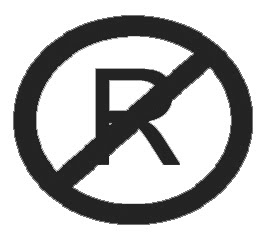"NO BROKEN GLASS" Symbol Fails to Function as a Trademark for Lighting Fixtures, Says TTAB
The Board affirmed a refusal to register the design shown below, for electric lighting fixtures, on the ground that the purported mark, as used by Applicant, would be perceived as merely informational and not as a source indicator. In re Halogen Lighting Products, Serial No. 78426018 (September 29, 2008) [not precedential].

Examining Attorney Sandra Manios argued that the specimens of use show the design used in connection with the wording "NO BROKEN GLASS," and thus the design functions only "to inform consumers that applicant's goods contain glass that will not break."

Applicant argued that the PTO has registered numerous other marks using the international prohibition symbol, and further that the proposed mark "is source indicative by creating an incongruity due to the complex design the broken wine glass [sic] and the relation of the design to Applicant's subject electric lighting fixture goods."
The Board pointed out once again that it is not bound by the actions of examining attorneys in assessing different marks for different goods. It must decide each case on its own merits.
As to the purported incongruity of the design, the Board failed to see the light:
"The fallacy in applicant's argument arises from the assumption that the depiction of a broken wine glass as part of a symbol on a box of applicant's goods would convey no relevant information to its customers."
The PTO's evidence established that, when used on a box, the image of a wine glass, or a broken wine glass, indicates that the goods inside are fragile. Moreover, the "international prohibition symbol," when combined with another symbol, means "no" or "not" with respect to the other symbol's meaning. Thus, the meaning of Applicant's design is "quite clear."

Applicant's proposed mark "readily, and without further thought or reasoning - conveys the information that the goods are not fragile," i.e., that the glass elements will not break. The durability of applicant's goods is a "central characteristic and a selling point of these goods."
The Examining Attorney demonstrated that the symbols comprising applicant's design have a recognized meaning, while Applicant failed to present evidence that, as used by Applicant, the symbols would be understood differently.
The Board therefore concluded that the design in question would be perceived as merely informational, and not as a trademark. It therefore affirmed the refusal to register under Section 1, 2, and 45 of the Trademark Act.
TTABlog wisecrack: Perhaps the Applicant might add this symbol adjacent the applied-for mark:
 Text Copyright John L. Welch 2008.
Text Copyright John L. Welch 2008.



0 Comments:
Post a Comment
<< Home